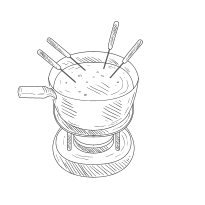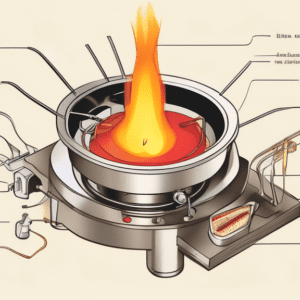Delving into the Science Behind the Fun
Fondue, the communal dining experience where bite-sized morsels take a delightful dip in a shared pot of melted goodness, has graced tables and warmed hearts for centuries. But have you ever paused, skewer in hand, to ponder the mechanics behind the heat source that keeps the fondue flowing? It’s more than just a flame; it’s a carefully orchestrated interplay of fuel, oxygen, and design. Join us as we unveil the science behind the fondue burner and explore the different types that fuel countless fondue feasts.
The Anatomy of a Fondue Burner
While specific designs vary, every fondue burner comprises a few essential components working in perfect harmony:
1. Fuel Reservoir:
This is the heart of the burner, housing the fuel source that powers the flame. Different fondue burners utilize various fuel types, each with advantages and characteristics:
a) Methylated Spirits (Denatured Alcohol):
A common choice, methylated spirits burn cleanly, producing minimal soot and odor. They ignite easily and offer consistent heat output, making them suitable for various fondue types. However, their flames can be difficult to see in daylight and require caution when refueling.
b) Gel Fuel:
Packaged in convenient canisters, gel fuel is known for its portability and ease of use. It’s less likely to spill than liquid fuels and offers a decent burn time. However, gel fuel generally provides a lower heat output compared to methylated spirits or butane.
c) Butane:
Butane burners deliver powerful, adjustable flames, making them ideal for larger gatherings or fondues requiring higher temperatures. They typically offer longer burn times than other fuel types and are refillable, adding to their environmental friendliness. However, butane canisters require proper handling and storage due to their pressurized nature.
2. Burner Assembly:
This component houses the wick (for liquid and gel fuels) or the gas release valve (for butane burners) and directs the flame upwards.
a) Wick Burners (Liquid/Gel Fuels):
These burners utilize a wick made of absorbent material that draws the fuel from the reservoir via capillary action. The wick is ignited, and the flame burns at its tip, providing heat to the fondue pot above.
b) Gas Release Valve Burners (Butane):
Butane burners feature a valve that controls the release of pressurized butane gas from the canister. When opened, the gas flows through a small nozzle, where it mixes with air and ignites, producing a powerful, adjustable flame.
3. Air Vents:
Crucial for combustion, air vents allow oxygen to reach the fuel source. Without sufficient oxygen, the flame would be weak or extinguish altogether.
4. Flame Adjuster:
Most fondue burners incorporate a mechanism to regulate the flame intensity. This can involve adjusting the wick height (for liquid/gel fuels) or controlling the gas flow (for butane burners). This control allows you to fine-tune the heat and maintain an optimal fondue consistency.
5. Base:
Providing stability and safety, the base supports the entire burner structure and often includes a heat-resistant surface to prevent damage to your table or tablecloth.
The Science of the Flame: How It All Works
At the heart of every fondue burner lies the fundamental principle of combustion—a chemical reaction requiring three key elements: fuel, oxygen, and heat.
1. Fuel:
Whether liquid, gel, or gas, fondue burner fuels contain combustible substances that readily react with oxygen.
2. Oxygen:
Air vents on the burner allow oxygen to reach the fuel source, enabling the combustion reaction.
3. Heat:
An initial heat source, like a match or lighter, is required to initiate combustion. Once ignited, the heat generated by the flame sustains the reaction.
When these three elements combine, a chemical reaction occurs, breaking down the fuel molecules and releasing energy in the form of heat and light, which is what we perceive as the flame. This heat transfer is what keeps your cheese perfectly melted and your chocolate delightfully dippable.
Choosing the Right Fondue Burner
The ideal fondue burner for your needs depends on various factors, including the type of fondue you’re preparing, the number of guests, and personal preference:
a) Fuel Type:
Consider the pros and cons of each fuel type mentioned earlier to determine which best suits your convenience, desired heat output, and environmental concerns.
b) Burner Size and Heat Output:
Larger fondue pots or those requiring higher temperatures, like oil fondue, will benefit from burners with a higher heat output, such as those utilizing butane.
c) Adjustability:
The ability to precisely control the flame intensity is crucial for maintaining optimal fondue consistency. Look for burners with reliable flame adjusters.
d) Safety Features:
Prioritize safety features like sturdy bases, heat-resistant handles, and secure fuel reservoirs to prevent accidents.
Fondue Burner Safety Tips
While fondue burners are generally safe to use, following these precautions ensures a safe and enjoyable fondue experience:
a) Read the Manual:
Always consult the manufacturer’s instructions for specific safety guidelines and operating procedures.
b) Use in Well-Ventilated Areas:
Proper ventilation is crucial when using any type of flame. Ensure adequate airflow in the room to prevent the buildup of carbon monoxide.
c) Place on Heat-Resistant Surfaces:
Always position the fondue burner on a heat-resistant surface, such as a trivet or heat-proof mat, to protect your table or tablecloth.
d) Never Leave Unattended:
A lit fondue burner should never be left unattended. Keep a watchful eye, especially when children or pets are present.
e) Extinguish Carefully:
Follow the manufacturer’s instructions for safely extinguishing the flame. Allow the burner to cool completely before refueling or storing.
Conclusion
The next time you gather around a bubbling pot of fondue, take a moment to appreciate the ingenious design and scientific principles at play. From the carefully engineered air vents to the precisely controlled fuel release, every component of a fondue burner contributes to a delightful and memorable dining experience. So, savor the moment, indulge in the deliciousness, and remember the fascinating science that brings warmth and flavor to your table.

